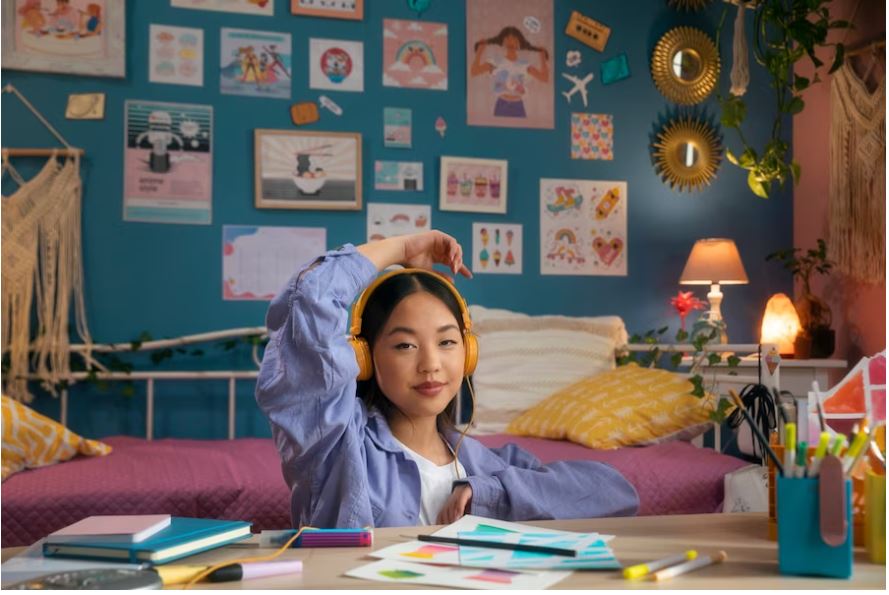- 40% of 304 respondents said their bedroom was their living space.
- Average hours spent in a sleep space was 9.31 (7.12 hours asleep).
- The biggest bedroom activity other than sleeping? Watching TV.
Today’s bedrooms are no longer simply a room with a bed where we can snooze. According to a recent study by the University of NSW, those private spaces once traditionally reserved for sleeping, are becoming more multifunctional in response to our growing spatial needs.
“We spend most of our time at home in the bedroom, but its use is expanding beyond its primary function as a sleep environment,” said Dr Demet Dincer, lead author of the study and interior architecture lecturer from UNSW Arts, Design & Architecture.
Just like eating, sleep is fundamental for humans to survive. But given that we spend around a third of our lives asleep, our domestic sleep spaces – and how we use them – are relatively unexplored from a design perspective. Meanwhile, other domestic rooms, such as the kitchen, have been closely studied by designers to determine their optimal design, layout and features.
Today’s bedroom: a utiliisation perspective
For the research, Dr Dincer’s team surveyed 304 Australian residents of different demographics, including age and gender, about their bedroom space and sleep habits. Around 40 per cent of respondents used their bedroom as their living space, while 61 per cent said they preferred to use it just for sleep.
Age, occupation and bedroom location all affected usage and preferences.
Dr Dincer said, “These initial findings help us better understand the different uses of the contemporary sleep environment and inform better design strategies for these spaces.”
Not just a bedroom
Dr Dincer said, “It is important to note today’s sleep environment might not be merely a room, including a bed, either.”
Overall, 90 per cent of respondents used their bedroom at least some of the time for sleeping, while the remaining 10 per cent either did not have a bedroom space for sleeping, or used it for a different purpose altogether.
“The ratio of participants who mentioned sleeping in spaces other than a permanent bedroom, such as sleeping in a car or a spare room, was not high,” Dr Dincer said.
A multifunctional sleep environment
According to the findings, the mean hours per day spent in a sleep environment are 9.31, while the mean hours spent sleeping are 7.12. There was no difference in the amount of time spent in the bedroom based on gender.
Younger participants also spent more time in their bedrooms than any other age group, while they were also more likely to use the space for activities other than sleep. More Students reported using the bedroom as a working area than respondents who worked from home.
It’s not surprising that young Australians are living at home where possible while studying, and working out of their bedrooms as their only private space. A recent Resolve Strategic survey found more than two-thirds (72 per cent) of Australians between the ages of 18 and 34 believe they will never be able to afford to buy their own home. And another recent survey by comparison site Finder said it’s possible to save $138,000 for a deposit over five years by living at home.
The UNSW study found respondents living in share housing were also more likely to use their bedroom as a work area, while those living in a studio apartment were more likely to use their sleep environment as a shared space.

A shrinking living space
Among the other activities people engaged in while in their “sleep environment”, watching TV was the highest activity – the study found – followed by reading, studying or working, eating and then exercising.
Dr Dincer said, “Almost half of our respondents said their bedroom was their living space, even though most don’t prefer that. However, we can’t change the reality that our domestic spaces, including the bedroom space, are shrinking and must accommodate more functions.”
As space, particularly in cities, becomes more of a premium, Dr Dincer said we need to rethink the different boundaries affecting the use of our sleep environments.
He said, “Bedrooms are one of our most private spaces. But how much we can personalise them is very limited in Australia, particularly for renter-occupiers.
“It would be ideal if our laws allowed renters more flexibility to customise their space beyond just furnishings, particularly if we intend to stay for an extended period” Dr Dincer said.
Designing for healthy sleep
Dr Christian Tietz, study co-author and senior lecturer in industrial design at UNSW, observed, “While a well-laid-out and equipped kitchen is no guarantee for tasty meals, it can make hygienic cooking of better-tasting meals easier than a poorly equipped and laid-out one. The same could be said for bedrooms and sleep.
Previous sleep studies suggest the sleep environment significantly influences sleep quality and problems like sleep apnea and insomnia.
In the next stage of the study, the research team will use the Creative Robotics Lab at UNSW’s Paddington Campus to collaborate with sleep experts and explore how different features and changes to the sleep environment affect sleep quality.
Dr Dincer said, “We’re looking forward to this important collaboration between designers and sleep researchers that should give us a more holistic understanding of what makes an optimal sleep environment and how they can be more flexible and responsive to changing spatial needs.”








